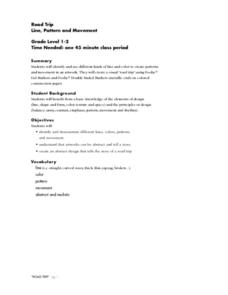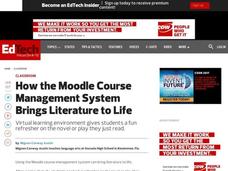New York State Education Department
Comprehensive English Examination: January 2014
What better way to prepare learners for academic success than to administer practice tests? With the Comprehensive Examination in English, scholars read informational and literary texts and answer listening and reading comprehension...
Curated OER
Comprehension: Setting
Students discuss what setting represents. In this language arts lesson, students review the three elements of setting: where the story takes place, when does the story take place, and is it past, present, or future? Students create a...
Curated OER
Story Scrapbook
Pupils develop a comparison worksheet using one non fiction book and one fiction book they have read to be put into a class scrapbook. In their comparison students must have title, author, point of view, setting, characters, and other...
Curated OER
Elements of a Short Story
Students analyze elements of a short story by working together. In this literature lesson, students analyze short stories. They use the TI Navigator Application to write their findings.
Curated OER
Story Writing
Second graders review the basic elements of a story. Individually, they write their own original story as they use a software program to help them map out their ideas. With a partner, they exchange papers and read them for grammatical...
Curated OER
Buildings Tell A Story
Fourth graders identify basic architectural features of buildings in their community and identify the changes in local buildings. They draw a sketch of a local building from memory. They compare and display student sketches.
Curated OER
Road Trip: Line, Pattern, and Movement
Students examine and explore various line, color, and movement elements in artwork. They view and discuss examples of abstract artwork, and create their own original abstract design that tells the story of a road trip.
Curated OER
The Time I Got Lost
Third graders go through the writing process but substitute paper and pencil with the computer to create a story about "The Time I Got Lost".
Curated OER
Predictions, Predictions, and More Predictions
Third graders pose questions about the subject of a short story based on the title and cover illustration; then read the story and determine if their questions actually pertained to the story line, and, if so, how the story answered the...
Curated OER
A Novel Idea
Students use Moodle to participate in a chat session to complete a character analysis for a novel they've studied. In this novel analysis and technology lesson, students are assigned a character from a specific chapter and use Moodle to...
Curated OER
The Art of Description
Students apply descriptive language to identify the five elements of art and the basic lines, geometric shapes, and angles in Marie Hull's, Sharecropper. They explain how the elements of a piece of work contribute to the story it tells....
Curated OER
Nature’s Fury—Myths and Drama
Fifth graders explore the elements of theatre. In this dramatic performances lesson, 5th graders discuss the structural elements of theatre and dramatize "The Origins of the Season," an explanation myth.
Curated OER
Reader's Theater with a Twist
Second graders create a Reader's Theater script. In this reader's theater lesson plan, 2nd graders create their own script of a story in groups. They make props and act them out on FlipVideo and voice thread.
Curated OER
Rebus Writing
Fifth graders write rebus stories using technology. They share the rebus stories with younger students
Curated OER
Plot Diagram
In this literature worksheet, students use this plot diagram to help identify key elements of a story. Students record information about the introduction, rising action, climax, falling action and resolution.
Curated OER
Mood and Tone
In this literary elements worksheet, students fill in the graphic organizer by writing down the mood and tone of the writing piece. There are three boxes for students to fill in details about the mood, as well as the tone.
Curated OER
Narrative Literature Response Letters: Original Lesson Plan
Readers write a formal letter to an author offering an alternative ending to a story the author has written. First, the class reads a story or novel. Upon finishing the reading, they are introduced to the format of a formal letter. They...
Curated OER
Acrostic Book Report
Learners read the story Wild Horse Winter and construct acrostic poems. In this poetry lesson, students use adjectives and events in the text to develop an acrostic poem.
Curated OER
Cardboard Radial Weaving
Students explore cultural history by participating in an arts and crafts activity. In this weaving lesson, students identify the many cultures that used weaving methods and local plant life to create baskets and other useful tools....
Curated OER
Black Bayou Lake Short Story
Tenth graders use Microsoft Word to create an original short story. The setting must be Black Bayou Lake National Wildlife Refuge. The characters must be animals found at Black Bayou Lake National Wildlife Refuge. The story must contain...
Curated OER
Using Photography To Enhance A Story
Students read text and study examples of good usable photography for newspapers. They see how to crop photos for maximum effect, and to better tell the story. They tell a sports story by choosing the best and fewer photos that have the...
Curated OER
Using Inspiration Software to Explore Characters In Stories
Students identify characters, their qualities, and examples of their qualities and use Inspiration to organize them in a clear and understandable format. After a lecture/demo, students use the program on the next story by themselves.
Curated OER
Problem & Solution Diagram
In this graphic organizer worksheet, students identify the key elements in a piece of literature. Students fill out the chart with the story's problem, character's goal, key events and the resolution.
Curated OER
Themes in Literature - Langston Hughes "Thank You Ma'm"
Eighth graders study Langston Hughes, "Thank You Ma'am" to discover the elements of plot, character motives and reactions. They express the effects of trust and kindness by writing a reflective personal narrative. They illustrate the...

























